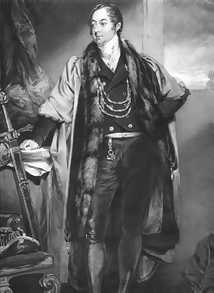Lawrence Dundas, 1st Earl of Zetland facts for kids
Lawrence Dundas, 1st Earl of Zetland (born April 10, 1766 – died February 19, 1839) was an important Scottish politician. He was also a peer, which means he held a special noble title. He served in the British Parliament for many years, from 1790 to 1820. After that, he received a higher noble title.
Contents
Early Life and Family
Lawrence Dundas was born in Westminster on April 10, 1766. His father was Thomas Dundas, 1st Baron Dundas. Lawrence went to Harrow and later studied at Trinity College, Cambridge.
He married Harriot Hale. She was one of 21 children of General John Hale. Lawrence and Harriot had three sons and four daughters together.
Political Journey
Lawrence Dundas began his political career as a Whig MP. An MP is someone elected to represent people in the country's government.
Serving in Parliament
In 1790, he was first elected MP for Richmond, North Yorkshire.
- Twelve years later, he became the MP for York.
- In 1808, he returned to represent Richmond again.
- By 1811, he was once more the MP for York.
Leading the City of York
While serving as an MP, Lawrence Dundas also took on roles in the city of York.
- He became an alderman (a senior member of the city council) in 1808.
- In 1811, he was chosen as Lord Mayor of York. The Lord Mayor is a ceremonial leader of a city.
- He served as Lord Mayor a second time in 1821.
Becoming a Peer
In 1820, Lawrence Dundas inherited his father's title, becoming the second Baron Dundas. This meant he moved from the House of Commons to the peerage of the United Kingdom.
He was also appointed Lord Lieutenant of Orkney and Shetland in 1831. A Lord Lieutenant is the King or Queen's personal representative in a county or area.
In 1838, something very special happened. During the coronation of Queen Victoria, Lawrence Dundas was given the title Earl of Zetland. This was because he had helped Queen Victoria's parents, the Duke and Duchess of Kent, with money before she became Queen. Zetland is another name for Shetland.
Historical Context: Slavery Compensation
During Lawrence Dundas's lifetime, slavery was a legal practice in some parts of the British Empire. After the Slavery Abolition Act 1833 ended slavery, the British government paid money to people who had owned enslaved individuals. This was called the Slave Compensation Act 1837.
Lawrence Dundas received compensation because he had owned enslaved people on plantations in Grenada and Dominica. Records show he owned 351 enslaved people and received a payment of £8,135 at that time. This money was given to slave owners to make up for their "loss" of enslaved people, even though slavery itself was a terrible system.
Later Life and Legacy
Lawrence Dundas's wife, Harriot, passed away in 1834. He died suddenly on February 19, 1839, at his home called Aske Hall in Yorkshire.
His oldest son, Thomas Dundas, 2nd Earl of Zetland, took over his titles and responsibilities. Lawrence Dundas is buried in his family's special burial place at Trinity Church in central Falkirk.
Images for kids



